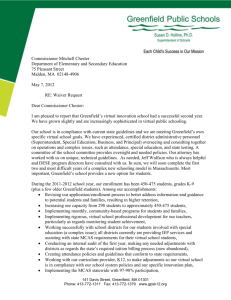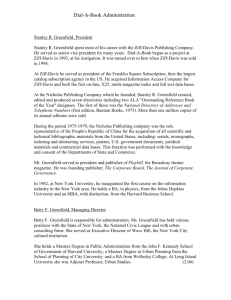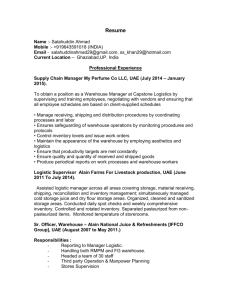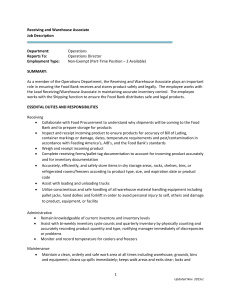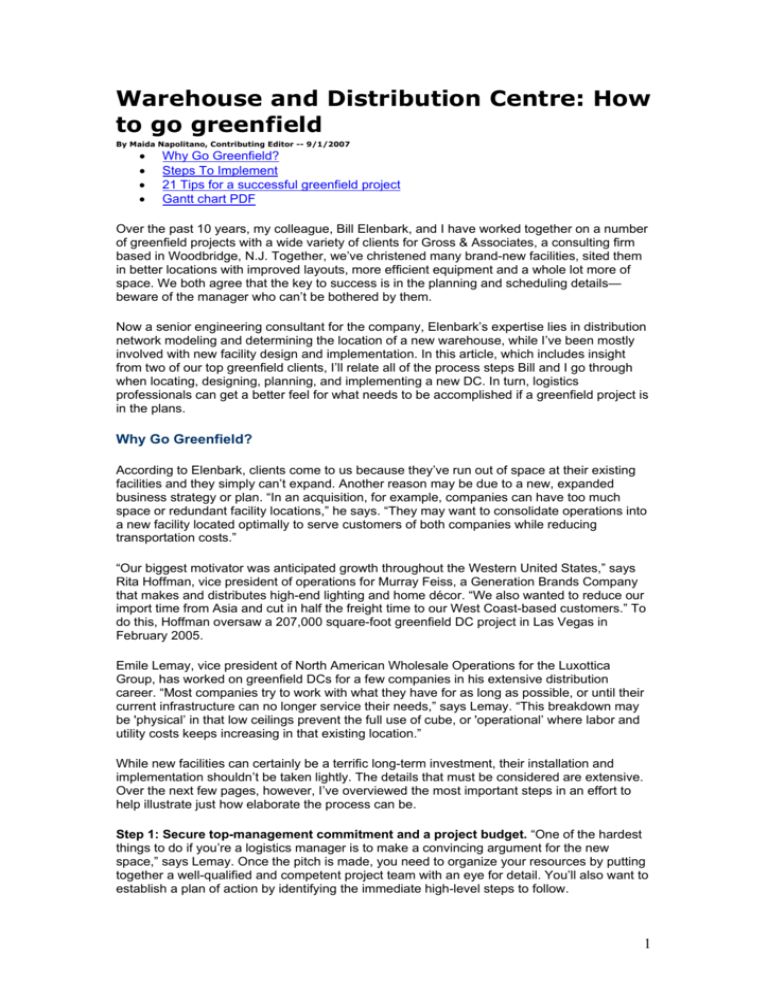
Warehouse and Distribution Centre: How
to go greenfield
By Maida Napolitano, Contributing Editor -- 9/1/2007
•
•
•
•
Why Go Greenfield?
Steps To Implement
21 Tips for a successful greenfield project
Gantt chart PDF
Over the past 10 years, my colleague, Bill Elenbark, and I have worked together on a number
of greenfield projects with a wide variety of clients for Gross & Associates, a consulting firm
based in Woodbridge, N.J. Together, we’ve christened many brand-new facilities, sited them
in better locations with improved layouts, more efficient equipment and a whole lot more of
space. We both agree that the key to success is in the planning and scheduling details—
beware of the manager who can’t be bothered by them.
Now a senior engineering consultant for the company, Elenbark’s expertise lies in distribution
network modeling and determining the location of a new warehouse, while I’ve been mostly
involved with new facility design and implementation. In this article, which includes insight
from two of our top greenfield clients, I’ll relate all of the process steps Bill and I go through
when locating, designing, planning, and implementing a new DC. In turn, logistics
professionals can get a better feel for what needs to be accomplished if a greenfield project is
in the plans.
Why Go Greenfield?
According to Elenbark, clients come to us because they’ve run out of space at their existing
facilities and they simply can’t expand. Another reason may be due to a new, expanded
business strategy or plan. “In an acquisition, for example, companies can have too much
space or redundant facility locations,” he says. “They may want to consolidate operations into
a new facility located optimally to serve customers of both companies while reducing
transportation costs.”
“Our biggest motivator was anticipated growth throughout the Western United States,” says
Rita Hoffman, vice president of operations for Murray Feiss, a Generation Brands Company
that makes and distributes high-end lighting and home décor. “We also wanted to reduce our
import time from Asia and cut in half the freight time to our West Coast-based customers.” To
do this, Hoffman oversaw a 207,000 square-foot greenfield DC project in Las Vegas in
February 2005.
Emile Lemay, vice president of North American Wholesale Operations for the Luxottica
Group, has worked on greenfield DCs for a few companies in his extensive distribution
career. “Most companies try to work with what they have for as long as possible, or until their
current infrastructure can no longer service their needs,” says Lemay. “This breakdown may
be 'physical’ in that low ceilings prevent the full use of cube, or 'operational’ where labor and
utility costs keeps increasing in that existing location.”
While new facilities can certainly be a terrific long-term investment, their installation and
implementation shouldn’t be taken lightly. The details that must be considered are extensive.
Over the next few pages, however, I’ve overviewed the most important steps in an effort to
help illustrate just how elaborate the process can be.
Step 1: Secure top-management commitment and a project budget. “One of the hardest
things to do if you’re a logistics manager is to make a convincing argument for the new
space,” says Lemay. Once the pitch is made, you need to organize your resources by putting
together a well-qualified and competent project team with an eye for detail. You’ll also want to
establish a plan of action by identifying the immediate high-level steps to follow.
1
To maintain objectivity and reduce pressure on the project team, present your plan before any
major crisis needs to be averted. Lemay suggests not waiting until you are literally out of
space. Provide a clear vision of the project’s expected deliverables, specifically the savings
and efficiencies gained with a new facility. But most importantly, specify a budget and have
management sign off on it.
Step 2: Determine the best geographic area for your new project. Finding the actual
greenfield to locate your project may not be intuitive. With multiple suppliers, coast-to-coast
customers, and other DCs, this one step can get extremely complicated.
However, using software to model the network not only simplifies matters, but also allows
managers to test different what-if scenarios for locating in one state versus another. “Today’s
network-modeling software can process all customer locations by zip code, including existing
inbound and outbound shipment methods and corresponding costs, existing source points
and warehouse locations, and current warehouse rates,” explains Elenbark. This data is then
validated against the existing distribution network.
Forecasts and other planned distribution strategies are then entered into the model, and
various options are tested. At the end of the study, an ideal distribution network plan is
suggested and an optimum geographic area is recommended. The program also provides
final product and customer allocation among warehouses, which in turn determines the new
facility’s capacity and size.
Step 3: Design a prototype facility. You’ll need to audit the existing operation and look for
ways to improve storage density, productivity, and order cycle time. By gathering this key data
you’ll be able to apply the appropriate forecasts to span the number of years you plan to stay
in the new facility.
You’ll also need to analyze quantitative data and create inventory and movement profiles of
SKUs. This allows you to identify SKU categories and determine the best ways to store and
move each category. For each aspect of the operation, generate alternatives and evaluate
them quantitatively and qualitatively. You can then select the plan with the best technological
and operational fit with the best return on investment—drafting software such as AutoCAD
helps speed the design and facility planning process.
Step 4: Select the best site in the geographic area. Armed with the prototype facility, it’s
time to select candidate building sites. “The network model can only provide a location
specific to a three digit zip code,” explains Elenbark. “There are usually cost savings to be
achieved within that zip code or its surrounding area.” The area defined by the three digit zip
code can be immense: One end of the area may have overly strict building codes while
another end may be more lenient. For one of our clients, we found that if they opened a new
warehouse 50 miles from the recommended zip code, they would save at least $100,000 in
pallet rack costs because of that town’s less stringent seismic requirements.
The dynamics involved in evaluating site selection are considerable. Key factors include labor
cost and availability; state and local taxes; zoning restrictions; insurance rates; utility rates;
and accessibility to interstate highways. First, identify the factors that most concern your
operation then work in concert with a commercial realtor to establish whether to lease or
purchase, build on greenfield land, or modify an already existing facility to suit your needs.
It’s also important to develop a matrix of pros and cons along with specific costs. Hoffman
says her team performed a detailed cost analysis to decide between Los Angeles and Las
Vegas. In the end, the difference in costs was negligible, so it came down to what she calls
“emotional issues.”
“The concept of being a big fish in a little pond, as opposed to L.A. where you are a little fish
in a big pond, was attractive to us,” explains Hoffmann. In the end, she says, Las Vegas had
a more business-friendly atmosphere. Local authorities, vendors and suppliers were eager to
2
work closely with her in all areas such as purchasing pallets, finding transportation, and
acquiring temporary office space.
Step 5: Finalize layout in the selected site and begin construction. In this step, you need
to make your design fit into the selected site’s specific parameters. Once completed, you can
begin creating detailed performance specifications for the building and all the equipment.
It’s important to work with local business authorities as well as the people operating
warehouses to get in touch with reputable contractors and equipment suppliers. You can then
send performance specifications out for bids and select contractors. Lemay says that he had
the assistance of a local commercial developer to help build a new warehouse to suit, which
was a terrific help. If an existing building is used, you may still need to hire contractors to
demolish and reconstruct areas of the facility to best suit your needs.
But most of all, stay on top of construction schedules, inspect the building, and confirm that it
is being built as planned. Contractors and architects are typically in charge of dealing with
building permits and inspections, but keep updated on construction developments and resolve
any delays.
Step 6: Implement. Put together an implementation team from operations, facilities, and IT.
Include representatives from contractors and equipment suppliers, engineers, and architects.
This team should be headed by an implementation coordinator.
At this stage it’s critical to develop a plan outlining every detail needed for the move into your
new facility. Use a scheduling tool to create and update the schedule, assign tasks to
personnel, and set up dependencies. Dependencies identify what needs to be done before
the next step can be completed—or what gets delayed when somebody drops the ball.
There are typically three major permits required when opening a new facility: building,
electrical, and fire. “Delays in the permitting process often affect the overall schedule,” says
Elenbark, so constant communication is a must. Weekly project meetings with the
implementation team will not only track progress towards project completion, but keeps
everyone informed of latest developments.
The goal is to begin operating out of the new facility as soon as possible. By the end of this
step, storage and material handling equipment should be installed; personnel should be hired
and trained; systems and equipment should be tested and debugged; and a certificate of
occupancy should be on hand. Only then can inventory be re-routed and received at this
location.
21 Tips for a successful greenfield project
1. Show your CEO that you’ve explored all options.
2. Don’t hesitate to hire consultants as a project partner.
3. Challenge forecasts. Show management their effect on inventory and movement to
see if they truly expect the business to grow that much within the projected design
period.
4. Beware of oversimplifying data and using averages. A plan is only as good as the
data and assumptions that are built into it.
5. Contact local business authorities, such as the Chamber of Commerce to assist in
site selection.
6. Consider staying close to the area of the old facility to maintain the same labor pool.
7. Watch inventory closely especially when increasing the number of DCs in your
network. Total safety stock will be higher in two-DC networks than a one-DC
network.
8. Avoid installing new warehouse management systems (WMS) at the same time as
a building move.
3
9. Consider bringing in 3PLs, but be sure to accurately compare the costs of how you
do business versus how they do business.
10. Consider subletting expansion space for the number of years that you don’t need it.
11. When installing complex mechanized systems and automation, consider first
simulating the operation. It lets you to test the concept on the computer—not on the
warehouse floor.
12. To save costs, consider purchasing used equipment. Make sure you test any used
equipment before purchasing.
13. Bring in local management or operations personnel as soon as possible. Hire ones
familiar with local authorities and contractors.
14. Set up the equipment necessary to obtain real-time control of the inventory as a first
priority.
15. Don’t lose control of the inventory. Make sure your systems are working to track
that inventory as soon as you receive it.
16. Rid yourself of obsolete or unwanted inventory before moving to a new DC. Don’t
make the mistake of moving these items.
17. Avoid rushing a project to completion because existing operations are scheduled to
shut down.
18. Get partial inspections and partial certificates of occupancy (COs).
19. Have all contractors and facility planners work from the same base plan or drawing.
Local building authorities sometimes impose changes to the design. The
implementation coordinator should take note of all changes, update the plans and
promptly circulate them to the appropriate parties.
20. Don’t forget the little things. New racks need signage. Inbound pallets need bar
coded license plates. New locations need to be entered into the system.
21. Use the latest technology and communication tools to plan and manage the project.
<< Return to Main Page | Print
© 2007, Reed Business Information, a division of Reed Elsevier Inc. All Rights Reserved.
4


